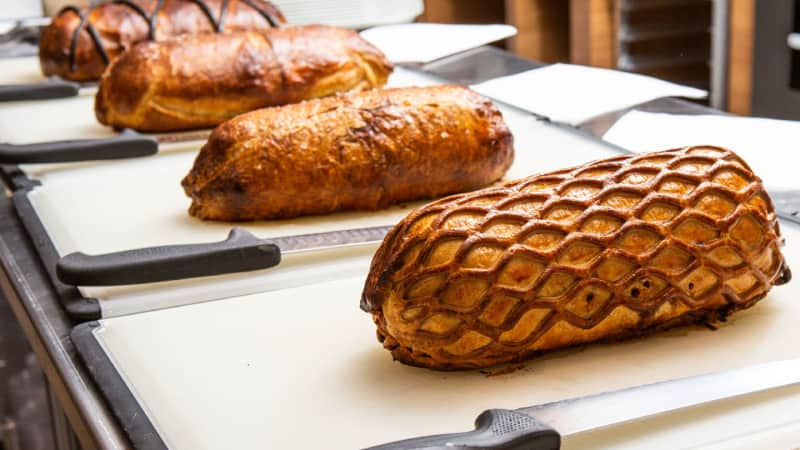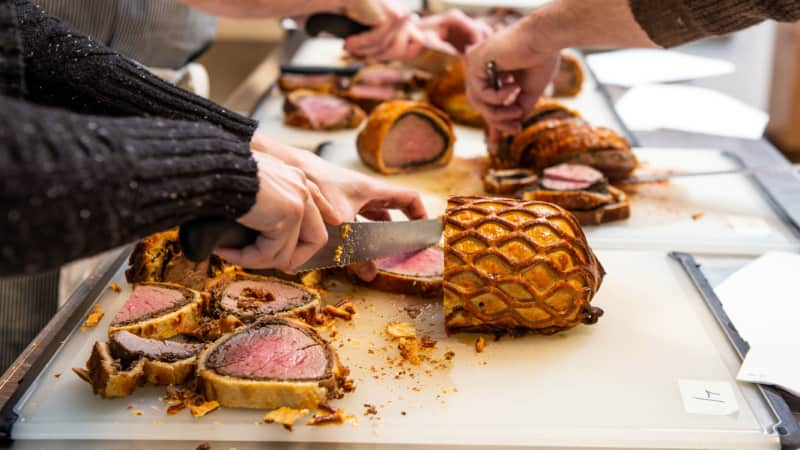Of all the recipes I’ve developed, none has made me as proud as beef Wellington. That’s not to say I wasn’t intimidated at first: The ingredients are expensive, there are multiple components to consider, and success is notoriously elusive. But over time, I figured out how to orchestrate the steps into a foolproof process to produce a stunningly beautiful—and delicious—dish.
Mastering Beef Wellington
Published Sept. 29, 2020.

Most beef Wellington recipes come together like this: Coat a well‑seared beef tenderloin in duxelles (finely chopped sautéed mushrooms), wrap it in crepes or thinly sliced prosciutto, top it with smears of liver pâté or slabs of foie gras, and encase everything in fancifully decorated pastry. Then slide it into the oven, fingers crossed that the beef emerges juicy and pink inside a crisp, golden crust.
I spent three days (and a staggering $600) evaluating five such recipes, and none fully justified the time or expense. However, there were bright spots: One Wellington featured deeply savory duxelles; another boasted medium-rare, juicy beef; and yet another had a beautifully crisp, golden crust.
Coming up with my own version was a tall mountain to climb, so I tackled the easy stuff first. I salted the beef overnight to enhance its flavor and ditched the dull crepes in favor of umami-rich prosciutto. I fortified the duxelles with shallots and a splash of Madeira and cooked it long enough to drive moisture from the mushrooms, concentrating their earthiness. Finally, I jettisoned the pâté, since its liver-y taste competed with rather than complemented the beef, and instead brushed the beef with Dijon mustard to add a complex kick. In the end, the package was so improved that I found I could skip the usual step of searing the meat.

Next, the pastry. Most modern recipes call for store-bought puff pastry, but the frozen dough often emerged from its package cracked where it had been folded and, as it warmed, was easy to tear. Once cooked, it slumped in spots and never fully crisped. However, one recipe from the innovators at ChefSteps promised success with pâte brisée, an all‑butter dough often used for tarts. Sure enough, this dough was easy to work with, even as I decorated the top of the Wellington with slender dough strips arranged on an elegant diagonal. Unlike the doughs of many other recipes I tried, which crumbled when sliced, this buttery, flaky crust was just sturdy enough to pass the slicing test.

My last challenge was simple to understand but hard to solve. Here’s the deal: Pastry requires high heat to set its shape, crisp, and brown. A beef roast, on the other hand, benefits from a low-and-slow approach to produce medium-rare meat from edge to center. A sample cooked in a 425-degree oven yielded a crisp, golden crust but overdone beef; 325 degrees produced rosy beef but slack, pale pastry.
It wasn’t until I called a side-by-side tasting that I had a breakthrough. I served the first roast while the other one waited nearby, and a lengthy discussion kept me from promptly returning to the second roast. When I finally sliced into it, the meat was gray, not pink. I had expected a certain amount of carryover cooking, but I was surprised at how significant the effect was here: This meat had been pushed to 150 degrees, well beyond my 130-degree target.
On-the-Counter Cooking
When you’re making an elaborate dish such as beef Wellington, the stakes are high: Anything less than juicy, rosy meat and a crisp, golden crust signals a disappointing waste of time and money. The conundrum is that well-browned pastry requires high heat, whereas medium-rare meat is generally produced via a low-and-slow approach.
The solution was to cook the Wellington in a 450-degree oven just until the pastry was well browned, at which point the meat was a mere 85 degrees. As the roast rested, the temperature at its center climbed 45 degrees, reaching a perfect 130-degree medium-rare in about 45 minutes.
The fix relies on the phenomenon known as “carryover cooking,” wherein meat continues to cook even after it is removed from a heat source. This happens for two reasons: First, the exterior of a large roast gets hot much more quickly than the interior. Second, because heat always moves from a hotter to a cooler area, as long as there is a difference in temperature between the two regions, heat will keep moving from the surface to the center. In our Wellington, the pastry also insulates the meat, so heat on its surface tends to travel toward the center rather than dissipate into the air during the carryover period.
So why not make carryover cooking work for me instead of against me? Thus began a series of tests in which I pulled the Wellington from the oven at progressively lower temperatures. In the end, I landed on a technique in which I blasted the Wellington in a 450-degree oven for 45 minutes until the crust was crisp, flaky, and golden and then removed it when the meat registered a mere 85 degrees. During a 45-minute rest on the counter, the temperature of the roast steadily climbed to 130 degrees.
It was Wellington perfection: When sliced, the roast exuded hardly any juice, and the well-seasoned, medium-rare tenderloin encased in savory duxelles, salty prosciutto, and crisp pastry was a sight to behold. I beamed as I served it with a luxe sauce of heavy cream, brandy, and piquant green peppercorns, knowing that it had been well worth the effort.

